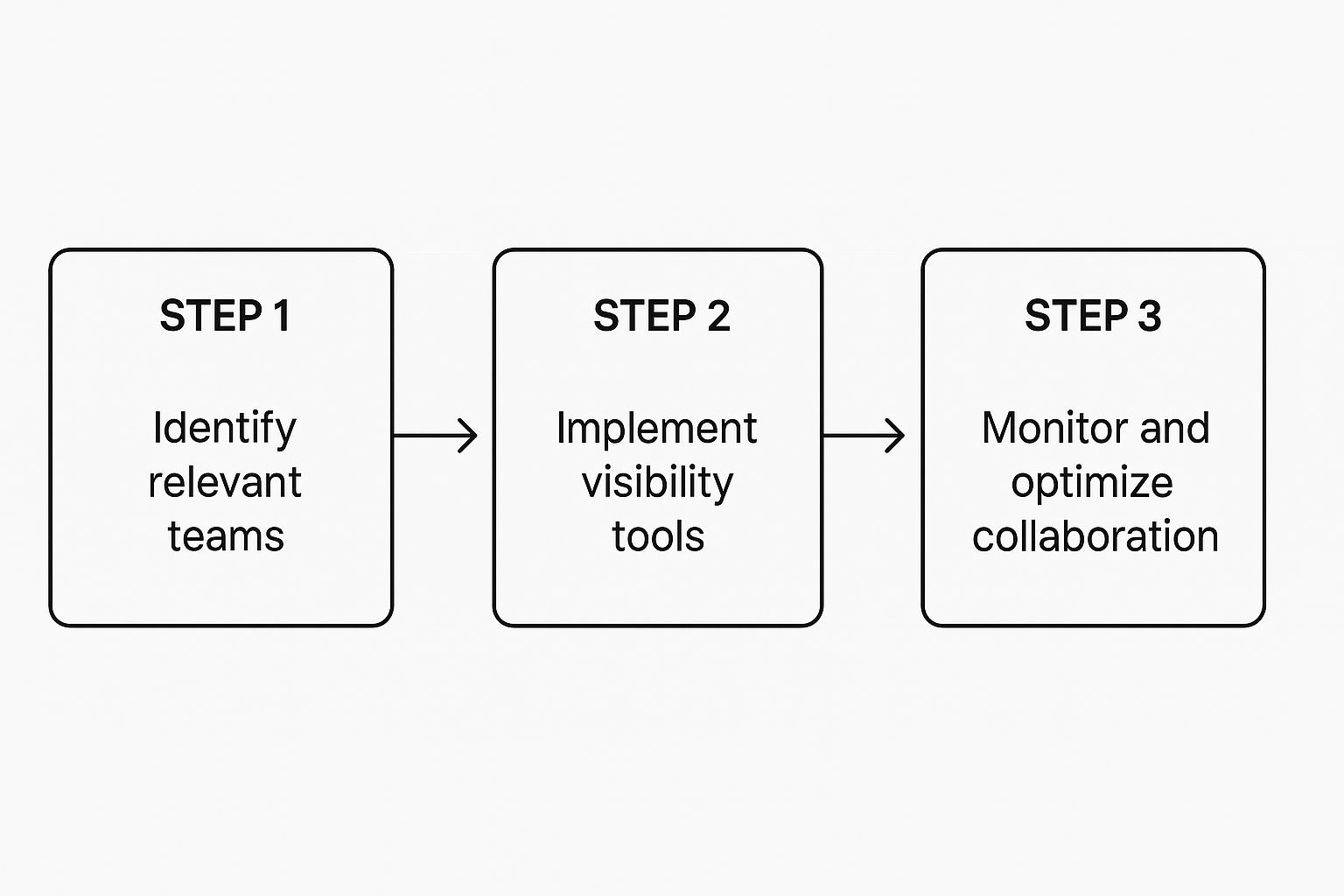When different departments—like marketing, engineering, and sales—can see each other’s project progress, timelines, and dependencies in real-time, that’s cross-team project visibility. It’s all about ditching the information silos and creating a shared, single source of truth that keeps everyone moving in the same direction.
Without it? Even the best teams eventually end up working against each other. It’s inevitable.
Why Your Teams Are Flying Blind

Let’s be real: modern projects often feel like organized chaos. When brilliant ideas get lost in translation, deadlines become suggestions, and budgets seem to evaporate, the root cause is almost always a lack of visibility. It’s the invisible friction you can feel but can’t quite pinpoint.
Think about this all-too-common scenario. Your marketing team is all hands on deck for a massive product launch, pouring resources into a campaign set to go live in two weeks. They’re working under the assumption that a killer new feature is right on schedule.
Meanwhile, over in engineering, a critical bug just pushed that feature’s deployment back by a month. But that crucial update is buried deep inside a Jira ticket nobody outside the dev team will ever see.
The result is a total disaster. Marketing launches a campaign for a feature that doesn’t exist, blowing the budget and eroding customer trust. This isn’t just a hypothetical nightmare; it’s the daily reality for countless organizations.
The Hidden Costs of Poor Visibility
This disconnect isn’t just inefficient; it’s expensive. The constant back-and-forth, the duplicated work, and the frantic search for the “latest version” of a plan all add up. These small frustrations snowball into major operational drag, stifling innovation and slowing growth. Breaking down these barriers is essential for any real cross-department collaboration.
By 2025, the hidden costs of miscommunication and project delays are expected to be a major pain point for businesses everywhere. This is why cross-functional teams, bringing together expertise from marketing, engineering, and customer service, are no longer a “nice-to-have.” They’re a necessity.
“When teams are blind to each other’s progress, they can’t anticipate roadblocks, manage dependencies, or pivot effectively. They aren’t collaborating; they’re just coexisting.”
This lack of a unified view is exactly why simple tasks spiral into complex nightmares. Below is a quick look at the everyday challenges caused by poor project visibility and the real impact they have on your business.
Common Visibility Problems and Their Hidden Costs
| Symptom | What It Looks Like | The Real Cost |
|---|---|---|
| Delayed Feedback Loops | A designer waits days for engineering input, only to find their designs are technically unfeasible, forcing a complete redo. | Wasted design hours, project delays, and team frustration. |
| Misaligned Priorities | The sales team promises a custom feature to a major client, unaware that engineering is already over capacity with critical bug fixes. | Unhappy clients, developer burnout, and potential churn. |
| Wasted Resources | Two different teams unknowingly build similar components for separate projects because there’s no central place to check for existing work. | Duplicated effort, bloated codebase, and wasted payroll. |
Ultimately, achieving genuine cross-team project visibility isn’t just about new software. It’s about fundamentally changing how your organization operates—transforming isolated groups into a cohesive, high-performing unit that actually works together.
So, everyone agrees that project visibility is basically a project management superpower. Why, then, does actually achieving it feel like trying to nail Jell-O to a wall?
The easy answer is “silos,” but let’s be honest, that’s just a symptom. The real culprits are much messier—the everyday habits and tool chaos that bog down even the most talented teams.
We’re talking about the digital spaghetti of fragmented workflows. Your product team practically lives in one system, marketing plans their entire quarter in another, and customer support is over in a third, tracking feedback. This isn’t just a little inefficient; it’s a breeding ground for version control nightmares and completely avoidable priority clashes.
This tool overload creates a constant, low-grade scavenger hunt for the “single source of truth.” Which spreadsheet has the final numbers? Did that critical update happen in some forgotten email thread or a Slack channel that’s now 200 messages deep? This digital mess makes accurate progress tracking a total pipe dream.
The Problem with Tool Sprawl
It’s so tempting to think adding another specialized app will solve a specific problem. But more often than not, it just adds another island of information to the archipelago.
Every new tool introduces another potential point of failure where crucial data gets lost, becomes outdated, or just plain forgotten. Without a central hub to connect everything, companies inevitably face inefficient resource allocation and, you guessed it, rising costs.
This fragmentation directly torpedoes cross-team project visibility. When information is scattered to the four winds, you completely lose the macro view. You have no way of seeing how a small delay in one team’s work is about to create a massive domino effect, slamming into three other departments down the line.
A lack of a unified platform means your teams are constantly translating information between systems. That isn’t collaboration; it’s manual, error-prone data entry that absolutely kills momentum and morale.
Cultural Hurdles and Ingrained Habits
Beyond the tech stack, there’s the human element. Let’s face it: teams develop their own unique ways of working, complete with their own jargon and unwritten rules. In isolation, that’s perfectly fine. But when you try to get these teams to collaborate, those unique processes become invisible barriers.
True transparency requires a cultural shift. It means moving from a guarded, “need-to-know” mindset to a more open “need-to-share” one. This can feel uncomfortable at first, especially since it exposes potential roadblocks and mistakes much earlier in the process. However, the first step is just understanding the foundations of how to achieve greater project transparency. This shift is especially critical when managing cross-functional teams where shared context is everything.
Overcoming these hurdles really comes down to a few key things:
- Standardizing Core Processes: It’s about agreeing on how updates are shared and tracked across all teams. No more guessing games.
- Championing Openness: This has to come from the top. Leadership needs to model transparent behavior, celebrating the lessons learned from both the wins and the failures.
- Choosing Integrated Tools: You have to adopt platforms that connect those disparate workflows, making sharing the default, not an extra chore.
By tackling both the technological mess and the cultural roadblocks, you can finally start dismantling the barriers that have been holding your projects back.
Choosing Your Collaboration Command Center
Picking the right software isn’t about chasing a flashy features list. It’s about finding a system that actually unites your teams instead of creating yet another information island. What you’re really after is a central command center that provides true cross-team project visibility, not just a prettier way to manage tasks in a vacuum.
This means you have to look past the basic Kanban boards and really zero in on the capabilities that solve those real-world visibility headaches. The market for these tools is absolutely booming, and for good reason. Projections show the project management software sector, valued at $7.24 billion in 2025, is expected to rocket to $12.02 billion by 2030. This isn’t just a trend; it’s a fundamental shift, with 82% of companies now using these platforms to get things done more efficiently. If you want to see the full picture, these project management statistics are pretty eye-opening.
So, what should you actually be looking for?
The Core Pillars of a Visibility Platform
When you’re kicking the tires on different tools, your evaluation really needs to boil down to three critical areas. These aren’t just features; they’re the foundational pillars that support a genuinely transparent, collaborative environment. Get these wrong, and even the most expensive software will fail to connect your teams in any meaningful way.
- Seamless Integrations: Your command center absolutely must talk to the tools your teams already use and love. A powerful, native integration, like the one connecting monday.com and Jira, is a perfect example. It lets your marketing team map out campaigns in monday.com while your developers crush sprints in Jira, with all the progress syncing between them automatically.
- Customizable Dashboards: Let’s be honest, different people need to see different things. Your CEO wants the 30,000-foot view of progress, while a project manager is down in the weeds looking at specific task dependencies. A great platform lets you build out custom dashboards that serve up exactly the right information to the right person, without all the noise.
- Intelligent Automation: Manual status updates are the enemy of productivity. They’re also a prime source of outdated, useless information. Look for tools that can automate the grunt work—things like changing a task’s status in one system when a corresponding ticket is closed in another. This frees up your team to do the actual work, not just report on it.

Think of it this way: your command center should be a translator, not a dictator. It should empower teams to stick with their preferred workflows while making sure everyone is speaking the same language when it comes to project goals and timelines.
Matching Features to Real-World Scenarios
Okay, let’s pull this out of the abstract and into a situation you’ve probably lived through. How does this actually play out in a real company?
Imagine a startup gearing up to launch a new mobile app. The product team lives in monday.com, where they’ve mapped out the entire launch strategy—from beta testing feedback to the App Store marketing blitz. The engineering team, on the other hand, lives and breathes Jira for bug tracking and development cycles.
Without a connected system, the product manager is stuck spending hours every week manually copying updates from Jira issues over to the monday.com board. It’s tedious, it’s a recipe for human error, and the data is always a step behind reality.
Now, let’s see how a powerful integration completely changes the game:
- A developer logs a critical, launch-blocking bug in Jira.
- That action instantly and automatically creates a linked “blocker” item on the monday.com launch board, pinging the product manager immediately.
- Once the bug is squashed and the Jira ticket is closed, the monday.com item is automatically updated to “Done,” signaling to everyone that the launch can move forward.
This is what a true command center does. It tears down the friction between teams and provides real-time, actionable insights. It turns disconnected groups into a single, unified force.
Designing Your Visibility Workflow
Having a powerful tool is one thing. Turning it into an unstoppable workflow? That’s where the real magic happens. This is your hands-on guide to building a system that pipes the right insights to the right people, exactly when they need them. The end goal is a central ‘mission control’ dashboard that completely kills manual reporting and guesswork, giving you a live pulse on your entire project landscape.
Let’s walk through a classic product launch scenario. Your marketing team is meticulously planning every campaign detail on a monday.com board. Meanwhile, your development team is deep in the trenches, managing sprints and squashing bugs in Jira. Without a proper connection, these two worlds might as well be on different planets. True cross-team project visibility means building a solid bridge between them.
The first move is to map out the critical dependencies. What information does marketing absolutely need from engineering to hit their deadlines? It’s almost always the status of key features and any launch-blocking bugs. On the flip side, engineering needs to see how their work tracks against the overall launch timeline that marketing and product are managing.
Creating Your Mission Control Dashboard
Your central dashboard shouldn’t just be a static report; it needs to be a dynamic, living overview of the project. This is where you’ll pull in specific data points from both monday.com and Jira to tell one cohesive story.
Here’s a battle-tested way to structure it for maximum impact:
- High-Level Timeline: Use a Gantt chart view in monday.com that syncs up with key Jira epic completion dates. This gives everyone—especially executives—a crystal-clear visual of the project’s progress against its deadline.
- Blocker and Risk Tracker: Create a dedicated section that automatically pulls in any Jira issue tagged as a “blocker” or a high-priority bug. This is your early warning system, ensuring potential delays are flagged instantly for all stakeholders to see.
- Team-Specific Views: Don’t create a one-size-fits-all view. A project manager needs to see a detailed breakdown of all tasks, while a team lead might only care about items assigned to their direct reports. Design custom views for different roles.
This process boils down to identifying the key teams, putting the right visibility tools in place, and then constantly tweaking the workflow to make it better.
This is a great visual breakdown of the core steps to lay a solid foundation for this kind of collaboration.

Ultimately, this flow ensures your visibility strategy isn’t just a one-time setup. It becomes a living process that evolves right alongside your team’s needs.
Automating Status Updates to Kill Busywork
The real game-changer in any integrated system is automation. Manual status updates are not only a soul-crushing time-suck, but they’re also a breeding ground for errors and delays. A study from Atlassian’s State of Teams report found that 55% of knowledge workers spend extra time just hunting down information. Automation gives that time back.
A perfect example? Set up a rule where closing a “launch-blocker” ticket in Jira automatically updates the corresponding task’s status to “Ready for Review” in monday.com. That simple automation means a developer never has to remember to manually ping the marketing team again.
This kind of automated communication keeps information current, accurate, and ready to be acted on. Of course, collecting the data is only half the battle; presenting it effectively is just as crucial. For anyone looking to level up their dashboards, exploring some visualization best practices can make a massive difference in how your team interprets and acts on project info. By designing a thoughtful, automated workflow, you turn your tools from simple task trackers into a powerful engine for collaboration.
Making Transparency a Team Habit

Getting your visibility workflow designed and deployed is a huge win, but it’s really only half the battle. The real work—and where you’ll find the lasting value—is embedding these practices into your company’s DNA. It’s about shifting the culture so that cross-team project visibility becomes the default, not a chore.
This kind of change doesn’t happen with a single memo. It’s built on small, consistent actions that slowly push out the old, siloed ways of working. One of the most powerful places to start is your cross-functional meetings.
Instead of sitting through static slide decks and listening to people read out their manual updates, make your live mission control dashboard the centerpiece. When the shared dashboard becomes the agenda, every discussion is automatically grounded in real-time, accurate data.
Running Data-Driven Meetings
Picture this: your weekly product launch sync-up kicks off, and everyone’s eyes are on the same monday.com dashboard. Instantly, a red flag is obvious—a critical Jira ticket from engineering is stalled, putting a marketing campaign deadline in jeopardy.
No one had to “report” this. The data is right there, impossible to ignore. The conversation can jump straight to problem-solving: What’s the blocker? Who can help? This simple shift makes meetings shorter, more focused, and infinitely more productive.
By making your shared dashboard the single source of truth for meetings, you eliminate subjective reporting and focus conversations entirely on actionable insights. It’s a habit that forces data-driven decision-making.
Of course, this level of openness requires some ground rules. This isn’t about oversharing every tiny detail; it’s about defining what information is actually crucial for other teams to see.
Building Lasting Transparency Habits
To make this new way of working stick, you need to think beyond the initial setup. Sustainable habits are what ensure visibility isn’t just a temporary project but a core part of how you operate.
- Establish Clear Communication Protocols: Define what gets shared, where it gets shared, and how often. For example, a simple rule could be: all launch-blocking issues must be flagged in Jira, which then automatically syncs to the main monday.com board. No exceptions.
- Create Feedback Loops: Don’t set it and forget it. Regularly ask teams what’s working and what isn’t. Is a dashboard view too cluttered? Is an automation firing at the wrong time? Use this feedback to continuously tweak and improve your workflow.
- Celebrate Transparency Champions: Publicly recognize the people and teams who are nailing it. When you highlight those who consistently share information and collaborate openly, you’re reinforcing the exact behavior you want to see across the entire organization.
The table below breaks down the shift from old, ineffective habits to the new practices that high-performing teams adopt.
Visibility Habits for High-Performing Teams
| Old Habit | New Habit | Why It Works |
|---|---|---|
| Reporting status in meetings with static slides. | Using a live, shared dashboard as the meeting’s agenda. | Discussions start with real-time data, cutting out fluff and getting straight to problem-solving. |
| Chasing down updates via email or Slack DMs. | Relying on the shared board as the single source of truth. | Everyone has access to the same information, which builds trust and reduces duplicate work. |
| Keeping team-specific knowledge locked away. | Proactively sharing key updates and blockers across teams. | It surfaces dependencies early, prevents surprises, and fosters a sense of shared ownership. |
| Waiting for someone to ask for information. | Making information accessible by default. | It empowers people to find answers on their own, speeding up decision-making across the board. |
Ultimately, cultivating these practices is what separates a team with a cool new tool from a truly connected and efficient organization. If you’re looking for more inspiration, exploring different team collaboration strategies can provide a wealth of ideas. By making these habits second nature, you ensure your investment in tools and processes pays off for years to come.
Your Cross-Team Visibility Questions Answered
Even with the best workflow and the slickest tools, questions are going to pop up. That’s perfectly natural! Let’s walk through some of the most common hurdles people face when they start pulling back the curtain for better cross-team project visibility.
Think of this as your guide to navigating the human side of transparency. Because connecting apps is one thing, but getting people to embrace a new way of working is the real mountain to climb.
How Do I Get Buy-In From Resistant Teams?
This is the big one, isn’t it? You’ll almost always run into a team that’s comfortable in their little bubble and sees this whole thing as just another form of “micromanagement.” The secret here is to frame visibility not as a top-down order but as the solution to their biggest frustrations.
Forget saying, “You need to share everything.” Instead, try asking, “What’s the most annoying part of your week?” The answers are usually things like chasing down information, sitting in endless status meetings, or getting blindsided by roadblocks from other departments.
Position your new, connected workflow as the direct answer to those specific pains. Show them how an integrated system means fewer pings, fewer interruptions, and more time for actual, focused work. When they see it as a tool that helps them, resistance pretty quickly turns into adoption.
What If We Share Too Much Information?
Information overload is a real and valid concern. The point isn’t to unleash a firehose of notifications that everyone immediately learns to ignore. It’s about getting the right signal through the noise, and this is exactly where customizable dashboards become your best friend.
A few practical tips I’ve seen work well:
- Define “Critical Path” Info: Not every single task update needs to be broadcast across the company. Get together and agree on what counts as a critical update—things like a blocker, a missed deadline, or a major milestone being completed—and then automate notifications for only those events.
- Use Role-Based Views: Your CEO doesn’t need to see every minor bug fix, and your engineers don’t need to see every marketing comment. Create specific, tailored views for different stakeholders that filter out the noise and show them only what they actually care about.
- Set Clear Communication Rules: Decide where different types of conversations should live. It’s fine to keep high-level strategic discussions on the main monday.com board, but let the nitty-gritty technical debates stay within the linked Jira tickets.
For any leader grappling with how to manage multiple projects simultaneously, setting these clear boundaries is absolutely non-negotiable. It’s how you make sure everyone gets the insights they need without feeling buried.
The goal of visibility isn’t to see everything; it’s to see everything that matters. Don’t be afraid to experiment and ask for feedback. You’ll have to tweak things to find the right balance for your unique teams.
How Long Does This Take To Implement?
Honestly, setting up the technical integration between tools like monday.com and Jira can be surprisingly quick. We’re often talking a matter of hours or days, not weeks.
The real timeline is all about the cultural shift. Getting teams to consistently adopt the new workflow and build new habits? That can take anywhere from a few weeks to a couple of months.
My advice? Start small. Pick one high-impact project involving a couple of teams that already work together and use it as a pilot program. Once you have a clear success story—backed by real results like fewer meetings and faster problem-solving—rolling it out to the rest of the organization becomes a much easier sell. This approach helps in breaking down silos in the workplace one piece at a time, instead of trying to change everything overnight.
Ready to finally bridge the gap between your teams? resolution Reichert Network Solutions GmbH offers the definitive monday.com for Jira integration to create a single, unified workspace. Embed monday.com for Jira and achieve true cross-team visibility today.
